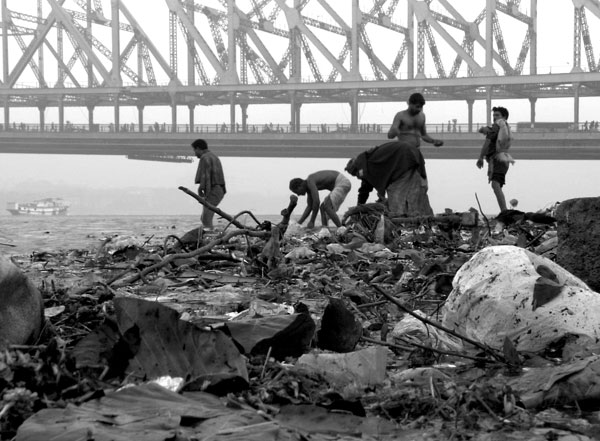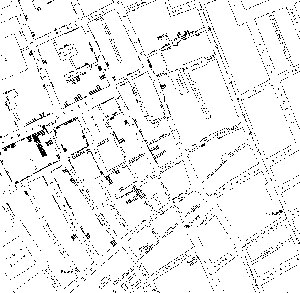Chapter 7
By Eugene F. Provenzo, Jr. and Cory A. Buxton
Water & Disease

| Florida Sunshine State Standards Benchmark | |
| SC.G. 1.2.1 | Plants, animals, and protists interact in different ways. |
|---|---|
| SC.G. 2.2.2 | The size of a population is dependent upon the available resources within its community. |
| SC.H. 1.2.2 | A successful method to explore the natural world is to observe and record, and then analyze and communicate the results. |
Cholera, Dr. Snow, and the Origins of Epidemiology
John Snow (1813-1858) was a British physician who became interested in finding ways to prevent the cholera epidemics that struck London in the 1840s. Cholera is a disease that is transmitted via water and food caused by the bacterium Vibrio cholerae. Snow wrote an article in 1849 in which he theorized that the disease was transmitted by infected water. His theory contradicted the more popular belief that the disease was caused by poisonous vapors.

The Ganges, India’s sacred river, is beseiged by trash, sewage and other forms of pollution.
In 1854, there was a particularly bad outbreak of cholera. Snow began collecting data, specifically mapping where the deaths occurred from the disease. He found that the center of the neighborhood where the deaths occurred had a well that had been used by all of the people who died. After he had the handle to the well removed by public officials so that no one could use it, the epidemic came to an end. While he could not determine the specific cause of the disease (something that would not take place for some years), he identified, through a process of deduction, the source of the disease’s transmission—i.e., infected water.
Activity: Finding the Source of the 1854 London Cholera Epidemic
In the following activity, you will look at the map of the 1854 cholera outbreaks in just the same way John Snow did. Can you determine which of the London water pumps was the carrier of the disease? Use the same logic that Snow did and see if you can come up with the same answer.
Materials Needed
John Snow’s map showing the cholera outbreak of 1854 in London. Each line indicates an individual who died from cholera. There are thirteen water pumps included in the map. There are 578 recorded deaths noted on the map.
Print off the Snow map from the Knowater website. Divide it into thirty-six equal squares as shown below.


Count up the total number of deaths in each square of the map. Then have students find the water pump which is closest to the heaviest concentration of deaths. It should lead them to the Broad Street Pump, which was, in fact, the site responsible for the infections. This method that the students have used is essentially the same one as that employed by John Snow over 150 years ago. His approach is widely recognized as the beginning of modern epidemiological research.
Have students review the following summary questions:
- How do logic and deduction lead to scientific knowledge?
- Can we treat a disease such as cholera without actually understanding what causes the disease? Why or why not?
Exploring One Water
In the film, Hindus are shown drinking water from the River Ganges. Is this celebration of water as a source of health potentially dangerous from a disease perspective?
Even though it is part of their religious belief that the Ganges water is good for one’s health, should people be prevented from drinking it? How could the water be made safer?
Lack of access to clean, safe drinking water plagues communities in the developing world.
Consider the Quote
“It is an extraordinary fact that the deliberate introduction of poisons into a reservoir is becoming a fairly common practice. The purpose is usually to promote recreational uses, even though the water must be treated at some expense to make it fit for its intended use as drinking water. When sportsmen of an area want to improve fishing in a reservoir, they prevail on authorities to dump quantities of poison into it to kill the undesired fish, which are then replaced with hatchery fish more suited to the sportsmen’s taste. The procedure has a strange Alice-in-Wonderland quality. The reservoir was created as a public water supply, yet the community, probably unconsulted about the sportsmen’s project, is forced either to drink water containing poisonous residues or to pay our tax money for treatment of the water to remove the poisons - treatments that are by no means foolproof. ” —Rachel Carson (1907-1964), “Surface Waters and Underground Seas,” Silent Spring, 1962
All of us need to be concerned with protecting our drinking water. Are there water pollution problems in the town or area where your students live? In the following activities, students will learn about pollution and how to prevent it.
Extension Activities
Elementary School Students
Create a list with students of the different ways water can become polluted. Talk with them about how we can help prevent pollution.
Multimedia
Have students write a contract that outlines ways they will try to prevent water from becoming polluted in their homes and at school.
Middle School Students
Have students work in teams to compile a list of ten ways that groundwater can be kept clean. This includes things like making sure that old paint around their homes is not poured down a drain, but taken to a hazardous waste disposal site. Similarly, batteries need to be taken to waste disposal sites and not simply thrown away. Have students design and create posters pointing out five ways people can do things around their homes to make sure that our groundwater remains as safe as possible.
Multimedia
Have students create a slide show talking about how to dispose of hazardous materials found around the house so that they will not cause damage to groundwater.
Secondary School Students
Have students go to the United States Environmental Protection Agency’s superfund site for Florida (http://www.epa.gov/superfund/sites/npl/fl.htm). Have them find three sites in their county or as nearby as possible and have them summarize in a brief one-page report what types of problems there are at sites, their cause, and what has to be done to get them cleaned up.
Multimedia
Have students create a film for YouTube or some other public site documenting hazardous or potentially dangerous conditions affecting water in their community or a nearby area.
